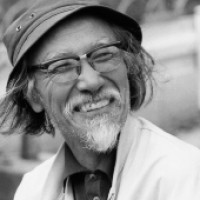Seijun Suzuki (real name Seitaro Suzuki) is a Japanese director and actor, most famous for his B-production yakuza films from the Nikkatsu period, characterized by his own style, as well as artistic films from the latter period of his career. At first he wanted to study agriculture, but did not pass the entrance exam. Instead, in 1942, he enrolled in the Hirosaki College, but got drafted only a year later. He spent WWII in the navy and later referred to his military experience as “comical”. After returning from war, he enrolled in the film department at the Kamakura Academy and in 1948 passed an exam to become an assistant director at the Shochiku film studio. He was an assistant to many directors, then in 1954 transferred to the Nikkatsu studio. After two years of working as an assistant, he made his directing debut in 1956 with the film
Minato no kanpai: Shôri o waga te ni (Harbour Toast: Victory Is in Our Grasp, 1956). After that, he made three to four films a year proving to be a skillful studio screenplay director. During eleven years of work in Nikkatsu, he directed about forty films, mostly yakuza, and several
pinku eiga films.
Akuma no machi (Satan's Town, 1956) is the first yakuza film he directed and
Ankokugai no bijo (Underworld Beauty, 1958), is the first film signed with the name Seijun Suzuki, which he was to use until the end of his career. The film
Yajû no seishun (The Man from Tokyo/Youth of the Beast, 1963) represents his commercial and stylistic turning point. In it, he began to develop his recognizable style, experimented with color and gradually placed more and more focus on visual style rather than a linear story. He achieved the peak of his career with the most famous films from the Nikkatsu period:
Tôkyô nagaremono (Tokyo Drifter, 1966) and
Koroshi no rakuin (Branded to Kill, 1967). Due to his style, he found himself in confrontations with his bosses. After the films
Akutarô (The Bastard, 1963),
Nikutai no mon (Gate of Flesh, 1964), and especially
Irezumi ichidai (Tatooed Life, 1965), his superiors demanded that he make more classical films. Nevertheless, he continued in his own style, and so after
Kawachi Karumen (Carmen from Kawachi, 1966) his already small budget for his next film dwindled further. After that, he made
Tôkyô nagaremono (Tokyo Drifter, 1966) in black and white, but remained faithful to his characteristic style of expression. Finally, after
Koroshi no rakuin (Branded to Kill, 1967), which Nikkatsu marked as ambiguous, the studio’s president, Hori Kyusaku, illegally terminated his contract. Moreover, the studio withdrew all of his films from distribution and Suzuki ended up suing the company. He won the case, but still ended up on a black list at all of the larger film studios, so he went to work in television for the next ten years, making films, series and commercials. At the same time, he worked as an actor in smaller roles. He returned to feature films in 1977 with the film
Hishu monogatari, produced in the Shochiku studio. This was the beginning of his second creative period, in which he made art films. After the medium-length
Ana no kiba (1979) he directed the film
Tsigoineruwaizen (1980), the first part of the
Taishō trilogy, which also includes
Kagerô-za (1981) and
Yumeji (1991). These are stylistically and thematically connected surreal psychological dramas set in the historical
Taishō period (1912-1926). The first film of the trilogy brought Suzuki critical acclaim and awards (Best Film and Best Director from the Japanese Academy in 1981). He also directed one anime film in collaboration with Shigetsugu Yoshida: the third part of the
Lupin series Rupan sansei: Babiron no Ôgon densetsu (Lupin III: The Gold of Babylon, 1985). His latest film is the romantic musical
Operetta tanuki goten (Princess Raccoon, 2005).
Filmography
Operetta tanuki goten (Princess Raccoon, 2005)
Pisutoru opera (Pistol Opera, 2001)
Kekkon (1993)
Yumeji (1991)
Rupan sansei: Babiron no Ôgon densetsu (Lupin III: The Gold of Babylon, 1985)
Kapone oi ni naku (1985)
Kazoku no sentaku (1983) (TV)
Kagerô-za (Heat Shimmer Theater, 1981)
Tsigoineruwaizen (1980)
Ana no kiba (1979) (medium length feature)
Hishu monogatari (1977)
Kyôfu gekijô umbalance (1973) (TV series, 1st episode)
Otoko no naka ni wa tori ga iru (1969)
Aisaikun konban wa: Aru kettou (Good Evening Dear Husband: A Duel, 1968) (TV, short feature)
Koroshi no rakuin (Branded to Kill, 1967)
Kenka erejî (Fighting Elegy, 1966)
Tôkyô nagaremono (Tokyo Drifter, 1966)
Kawachi Karumen (Carmen from Kawachi, 1966)
Irezumi ichidai (Tatooed Life, 1965)
Akutarô-den: Warui hoshi no shita demo (1965)
Shunpu den (Story of a Prostitute, 1965)
Oretachi no chi ga yurusanai (Our Blood Will Not Forgive, 1964)
Nikutai no mon (Gate of Flesh, 1964)
Hana to dotô (The Flowers and the Angry Waves, 1964)
Kanto mushuku (Kanto Wanderer, 1963)
Akutaro (The Bastard, 1963)
Yajû no seishun (Youth of the Beast, 1963)
Kutabare akutô-domo - Tantei jimusho 23 (Detective Bureau 2-3: Go to Hell Bastards, 1963)
Ore ni kaketa yatsura (1962)
Hai tiin yakuza (1962)
Hyakuman-doru o tatakidase (1961)
Blood-Red Water in the Channel (1961)
Toge O Wataru Wakai Kaze (New Wind Over the Mountain Pass, 1961)
Sandanju no otoko (The Man with the Hollow-Tip Bullets, 1961)
Muteppo-daisho (A Hell of a Guy, 1961)
Tokyo naito (Tokyo Knight, 1961)
Kutabare gurentai (1960)
Subete ga kurutteru (1960)
Clandestine Zero Line (1960)
Kemono no nemuri (1960)
Sono gosôsha wo nerae: 'Jûsangô taihisen' yori (Take Aim at the Police Van, 1960)
Suppadaka no Nenrei (1959)
Ankoku no Ryoken (1959)
Rabu retâ (Love letter, 1959)
Kagenaki koe (Voice Without a Shadow, 1958)
Aoi Chibusa (1958)
Fumihazushita haru (1958)
Ankokugai no bijo (Underworld Beauty, 1958)
Hachijikan no kyôfu (1957)
Ukigusa no yado (1957)
Rajo to kenju (1957)
Akuma no machi (1956)
Hozuna wa utau: Umi no junjo (1956) (srednjemetražni)
Minato no kanpai: Shôri o waga te ni (Harbour Toast: Victory Is in Our Grasp, 1956)
